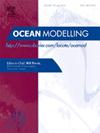大陆架环流影响海岸海湾的冲刷时间
IF 2.9
3区 地球科学
Q2 METEOROLOGY & ATMOSPHERIC SCIENCES
引用次数: 0
摘要
一旦从河口进入陆架,物质的运输和滞留就会受到陆架动力学的影响,有时也会受到深海动力学的影响。然而,以往的海岸模式研究很少考虑深海的影响,因为海岸模式通常只对沿海区域具有较好的分辨率,而且区域很少延伸到大陆架(深度<;200 m)之外。本研究论证了深海环流和陆架环流对河口湾冲淤的作用。利用墨西哥湾西北部的跨尺度和校准良好的海洋模型(粗小模型)和整个墨西哥湾的另一个模型(精细大模型),我们通过拉格朗日粒子跟踪模拟研究了加尔维斯顿湾的冲刷时间。关于海岸附近的盐度和水流,两种模式都有相似的结果,但与精细大模式相比,粗小模式分别持续高估/低估了冬季/夏季的冲刷时间。对海面高度和地转流的分析表明,由于粗小模式无法捕捉深海天气环流,导致对河口物质在内陆架上的滞留量估计过高,对沿海海湾冬季的冲刷时间估计不现实。通过将深海湾的分辨率从10公里提高到5公里,精细小模式产生的结果与精细大模式相似。本研究强调了陆架和深海动力学在河口湾和沿海海洋交换中的作用,并强调了在以河口和沿海水域为重点的模式中解决陆架范围动力学的重要性。本文章由计算机程序翻译,如有差异,请以英文原文为准。
Shelf-wide circulation impacts the flushing time of coastal bays
Once exiting an estuary into the shelf, transport and retention of materials are subject to the shelf dynamics, and sometimes the deep ocean dynamics. However, the impact of the deep ocean is rarely considered in previous coastal modeling studies, as coastal models typically have a fine resolution only for the coastal region and the domain rarely extends beyond the shelf (depth <200 m). This study demonstrates the role of deep and shelf ocean circulation on the flushing of estuarine bays. With a cross-scale and well-calibrated ocean model for the northwestern Gulf of Mexico (Coarse Small Model) and another one for the entire Gulf of Mexico (Refined Large Model), we examine the flushing time for Galveston Bay through Lagrangian particle-tracking simulations. Both models have similar results regarding salinity and currents near the coast, but Coarse Small Model persistently overestimates/underestimates the flushing time during winter/summer, respectively, compared to Refined Large Model. Analysis of sea surface height and geostrophic currents suggests that Coarse Small Model’s inability to capture the deep ocean synoptic circulations leads to the overestimations of estuarine materials’ retention on the inner shelf and unrealistic flushing time for coastal bays during winter. By increasing the resolution in the deep Gulf from 10 to 5 km, Refined Small Model produces results similar to Refined Large Model. This study highlights the role of shelf and deep ocean dynamics on exchange between estuarine bays and coastal ocean and emphasizes the importance of resolving the shelf-wide dynamics in models focusing on estuarine and coastal waters.
求助全文
通过发布文献求助,成功后即可免费获取论文全文。
去求助
来源期刊

Ocean Modelling
地学-海洋学
CiteScore
5.50
自引率
9.40%
发文量
86
审稿时长
19.6 weeks
期刊介绍:
The main objective of Ocean Modelling is to provide rapid communication between those interested in ocean modelling, whether through direct observation, or through analytical, numerical or laboratory models, and including interactions between physical and biogeochemical or biological phenomena. Because of the intimate links between ocean and atmosphere, involvement of scientists interested in influences of either medium on the other is welcome. The journal has a wide scope and includes ocean-atmosphere interaction in various forms as well as pure ocean results. In addition to primary peer-reviewed papers, the journal provides review papers, preliminary communications, and discussions.
 求助内容:
求助内容: 应助结果提醒方式:
应助结果提醒方式:


